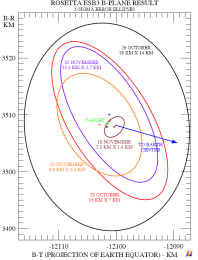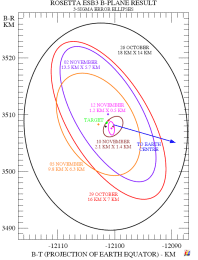No. 124 - Successful Earth swingby
The navigation has been extremely precise and the spacecraft is now on the final leg of its journey towards comet 67P/Churyumov-Gerasimenko.
The science observations during the swingby were successfully performed.
Mission operations have been mainly conducted with support of the ESA New Norcia (NNO) ground station. In addition several tracking passes with the ESA Kourou (KRU) and Maspalomas (MSP) ground stations as well as the NASA DSN ground stations Goldstone (DSS-24), Madrid (DSS-54) and Canberra (DSS-34) were scheduled in support of the Earth swingby operations.
| DOY | Date | Pass | Main Activity |
| 311 | 07/11/09 | DSS-24 2081 NNO 2081 DSS-54 2082 |
Monitoring pass |
| 312 | 08/11/09 | NNO 2082 |
Monitoring pass |
| 313 | 09/11/09 | NNO 2083 DSS-54 2084 |
Monitoring pass |
| 314 | 10/11/09 |
DSS-24 2084 |
Monitoring pass |
| 315 | 11/11/09 |
NNO 2085 |
Monitoring pass |
| 316 | 12/11/09 |
DSS-24 2086 |
Switch to LGA-S |
| 317 | 13/11/09 |
DSS-34 2087 |
Monitoring pass Perigee passage (closest approach at 2480 km) Tracking Monitoring pass Monitoring pass |
Early on the last day in the reporting period (DoY 317.07:45:40 UTC) Rosetta was at closest approach during the third Earth swingby, at about 2480 km from the Earth's surface (0.00001654 AU). The one-way signal travel time was 8.27 milliseconds. The distance to the Sun was 148.25 million km (0.99 AU).
Navigation Campaign
The navigation campaign leading up to the third Earth swingby has been concluded nominally. After the primary trajectory correction manoeuvre (TCM) on 22 October, no further TCM has been required.
Information on Rosetta's inbound trajectory came from telemetry transmitted by Rosetta and from Doppler and ranging data received from the ESA and NASA ground stations that are tracking the spacecraft regularly.
The two figures below are B-plane plots illustrating the status of the navigation campaign in preparation for the third Earth swingby up to 1 day before closest approach. The navigation error ellipses are indicated based on radiometric data up to 10 November, 09:00 UTC (figure at left) and up to 12 November, 13:00 UTC (figure at right).
The B-plane is a planar coordinate system that allows targeting during a gravity assist. The target point of Rosetta's approach trajectory relative to the Earth in the B-plane is marked green in the plots below. Note: this is not the point of closest approach. Instead this virtual point corresponds to what would be Rosetta's miss-distance if the Earth had no gravity.
 |
 |
|
B-plane plot for Rosetta's third Earth swingby with the navigation results and error ellipses up to 10 November, 09:00 UTC (left) and 12 November, 13:00 UTC (right). | |
Towards comet 67P/Churyumov-Gerasimenko
Following the successful Earth swingby the spacecraft trajectory now is such that it will be possible to reach comet 67P/Churyumov-Gerasimenko in 2014. Rosetta's current orbit has an aphelion at about 5.33 AU and a perihelion still bound to 1 AU.
In order for the spacecraft to match the comet's orbit it will be necessary to perform two major manoeuvres in January 2011 and May 2014 with a delta-V of about 800 ms-1 each. These manoeuvres will put Rosetta onto a heliocentric orbit matching that of the comet.
At this stage the spacecraft is travelling at a heliocentric speed of about 38.7 kms-1 (against the initial value of 30 kms-1 after launch in 2004) and will soon enter a range of Sun and Earth distances it has not reached so far. As from mid July 2010, Rosetta will have the record Sun distance for solar-array-powered spacecraft when it crosses the 2.72 AU distance from our parent star.
Spacecraft
Payload
At the start of the reporting period OSIRIS, MIRO and VIRTIS were gradually switched on. Together with ALICE, observations of the Moon were performed on 8 November to determine the relative boresights of these four remote sensing instruments. On 9 November the RPC instrument was switched on. All five instruments were active during the third Earth swingby, performing observations of the Earth-Moon system. For full details see also "Rosetta's observations during the third Earth swingby" in the right-hand menu. In addition, the Standard Radiation Environment Monitor (SREM) continues to run in the background.
ALICE
The instrument is operated as part of the third Earth swingby campaign.
CONSERT
The instrument is currently OFF.
COSIMA
The instrument is currently OFF.
GIADA
The instrument is currently OFF.
MIDAS
The instrument is OFF.
MIRO
The instrument is operated as part of the third Earth swingby campaign.
OSIRIS
The instrument is operated as part of the third Earth swingby campaign.
ROSINA
The instrument is OFF.
RPC
The instrument is operated as part of the third Earth swingby campaign.
RSI
The instrument is muted.
VIRTIS
The instrument is operated as part of the third Earth swingby campaign.
LANDER Philae
The instrument is currently OFF.
SREM
Since DoY 251/2009 the accumulation settings are configured for active cruise mode.
Future Milestones
The third and last Earth swingby manoeuvre of the mission was conducted as planned and preliminary data analysis shows excellent results. Fine orbit determination computation will be conducted in the next days in order to assess the need and the optimal time for a correction manoeuvre should this be required.
The Earth swingby phase will now continue for the next couple of weeks during which further activities are planned (scientific observations of the Earth-Moon system, tests with navigation camera in view of the asteroid Lutetia flyby in July 2010).
In the second half of January 2010 another important milestone is planned: the test of the Deep Space Hibernation Mode. This challenging operation is needed to validate the procedure planned for June-July 2011, when Rosetta will go into deep space hibernation for a period of two and a half years, until January 2014.
Two major trajectory manoeuvres are planned right before and after the deep space hibernation. These will synchronize Rosetta's orbit with that of comet 67P/Churyumov-Gerasimenko, leading up to the spacecraft's rendezvous with the comet in May 2014.
---
Legal disclaimer
This report is based on the ESOC mission operations report, WOR #124. Please see the copyright section of the legal disclaimer (bottom of this page) for terms of use.


